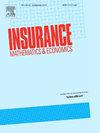Robust time-consistent Stackelberg differential game for insurance with stochastic interest rates and 4/2 stochastic volatility
IF 2.2
2区 经济学
Q2 ECONOMICS
引用次数: 0
Abstract
This paper studies the robust time-consistent investment-reinsurance problem for an insurer and a reinsurer under the framework of the Stackelberg stochastic differential game, in which the reinsurer is the leader and the insurer is the follower. The insurer hedges the claim risk by purchasing proportional reinsurance, and both the insurer and reinsurer can invest in a financial market consisting of a risk-free asset, a stock, and a rolling bond to manage risk. The interest rates and the volatility of stock price are assumed to obey the affine term-structure model and the 4/2 stochastic volatility model, respectively. Assume that both the insurer and the reinsurer are ambiguity-averse, and we establish the robust optimal control problem for an insurer and a reinsurer under the mean-variance criterion, respectively. Robust time-consistent investment and reinsurance strategies are determined by the Stackelberg equilibrium of the game, which considers the interests of both the insurer and the reinsurer and reflects the information asymmetry between the two parties. By employing the stochastic optimal control theory, we derive the robust time-consistent Stackelberg strategies. Finally, some sensitivity analysis and comparative analysis are presented to illustrate the results obtained.
具有随机利率和4/2随机波动率的保险稳健时一致Stackelberg微分对策
本文研究了在Stackelberg随机微分对策框架下,再保险人是领导者,保险人是跟随者的保险人和再保险人的稳健时间一致投资再保险问题。保险公司通过购买比例再保险来对冲理赔风险,保险公司和再保险公司都可以投资于由无风险资产、股票和滚动债券组成的金融市场来管理风险。假设利率和股价波动分别服从仿射期限结构模型和4/2随机波动模型。假设保险人和再保险人都是歧义厌恶者,分别在均值-方差准则下建立了保险人和再保险人的鲁棒最优控制问题。稳健的时间一致性投资和再保险策略由博弈的Stackelberg均衡决定,该博弈考虑了保险人和再保险人双方的利益,反映了双方的信息不对称。利用随机最优控制理论,导出了鲁棒时一致Stackelberg策略。最后,对所得结果进行了敏感性分析和对比分析。
本文章由计算机程序翻译,如有差异,请以英文原文为准。
求助全文
约1分钟内获得全文
求助全文
来源期刊

Insurance Mathematics & Economics
管理科学-数学跨学科应用
CiteScore
3.40
自引率
15.80%
发文量
90
审稿时长
17.3 weeks
期刊介绍:
Insurance: Mathematics and Economics publishes leading research spanning all fields of actuarial science research. It appears six times per year and is the largest journal in actuarial science research around the world.
Insurance: Mathematics and Economics is an international academic journal that aims to strengthen the communication between individuals and groups who develop and apply research results in actuarial science. The journal feels a particular obligation to facilitate closer cooperation between those who conduct research in insurance mathematics and quantitative insurance economics, and practicing actuaries who are interested in the implementation of the results. To this purpose, Insurance: Mathematics and Economics publishes high-quality articles of broad international interest, concerned with either the theory of insurance mathematics and quantitative insurance economics or the inventive application of it, including empirical or experimental results. Articles that combine several of these aspects are particularly considered.
 求助内容:
求助内容: 应助结果提醒方式:
应助结果提醒方式:


